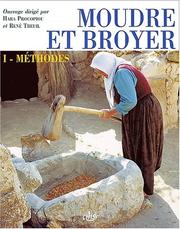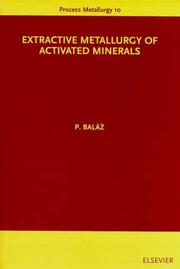| Listing 1 - 6 of 6 |
Sort by
|
Book
ISBN: 0408705744 Year: 1974 Publisher: London : Butterworths,
Abstract | Keywords | Export | Availability | Bookmark
 Loading...
Loading...Choose an application
- Reference Manager
- EndNote
- RefWorks (Direct export to RefWorks)
Materials processing --- fysicochemie --- Pharmacotechnology. Preparations --- 621.92 --- Size reduction of materials --- Comminution --- Grinding (Size reduction) --- Particle size reduction --- Mills and mill-work --- Abrasive materials and tools. Grinding and allied techniques. Crushing, separating, mixing of abrasives --- 621.92 Abrasive materials and tools. Grinding and allied techniques. Crushing, separating, mixing of abrasives --- Size reduction of materials. --- Fragmentation.
Book
ISBN: 9630502313 Year: 1974 Publisher: Budapest Akadémiai Kiado
Abstract | Keywords | Export | Availability | Bookmark
 Loading...
Loading...Choose an application
- Reference Manager
- EndNote
- RefWorks (Direct export to RefWorks)
621.92 --- Size reduction of materials --- Powders --- #KVIV --- Powder --- Bulk solids --- Crystals --- Comminution --- Grinding (Size reduction) --- Particle size reduction --- Mills and mill-work --- Abrasive materials and tools. Grinding and allied techniques. Crushing, separating, mixing of abrasives --- 621.92 Abrasive materials and tools. Grinding and allied techniques. Crushing, separating, mixing of abrasives
Book
ISBN: 9630515768 Year: 1980 Publisher: Budapest : Akadémiai Kiadó,
Abstract | Keywords | Export | Availability | Bookmark
 Loading...
Loading...Choose an application
- Reference Manager
- EndNote
- RefWorks (Direct export to RefWorks)
621.921 --- Grinding wheels --- Abrasives --- Ceramic materials --- Ceramic industries --- Ceramics --- Mines and mineral resources --- Abrasive wheels --- Grindstones --- Grinding and polishing --- Grinding machines --- Abrasives. Grinding materials. Polishing materials --- Materials --- Abrasives. --- Ceramic materials. --- Grinding wheels. --- 621.921 Abrasives. Grinding materials. Polishing materials --- Ceramics. --- Binders --- Grinding (size reduction)

ISBN: 2735505022 2735505057 9782735505029 9782735505050 Year: 2002 Volume: 3 Publisher: Paris: Éditions du Comité des travaux historiques et scientifiques,
Abstract | Keywords | Export | Availability | Bookmark
 Loading...
Loading...Choose an application
- Reference Manager
- EndNote
- RefWorks (Direct export to RefWorks)
La farine moulue aux meules est aujourd’hui un argument de vente efficace des pains dits traditionnels. Les outils et les techniques de broyage et de mouture ont donc toujours joué un rôle important dans la préparation de la nourriture.Mais on s'aperçoit de plus en plus qu'ils ont servi à bien d'autres usages et que leur histoire est riche et complexe. Certains animaux savent déjà concasser des noix. L'homme, lui, n'a jamais cessé de perfectionner ses outils et de les adapter à de nouveaux usages. Chaque époque a donc « ses » meules, qui reflètent son niveau technique, ses capacités d'emprunt ou d'innovation et ses conditions socio-économiques. Les méthodes scientifiques modernes révèlent en outre, par-delà la simplicité des outils, la diversité des matières (colorants, minerais…) qui ont pu être traitées et la variété parfois insoupçonnée des produits qui en ont été tirés.Elles nous font enfin pénétrer – et c'est le plus inattendu – dans l'organisation de chaque société : ce sont d'abord les femmes qui actionnent les meules à va-et-vient, souvent en s'aidant de chants rythmiques; mais les meules rotatives, qui permettent une productivité accrue et un changement d'échelle, sont prises en charge par des hommes…Diverses voies d'approche sont illustrées dans ce volume 1 : études pétrographiques sur les roches utilisées, examen des traces d'utilisation et analyses de résidus, approche expérimentale, démarches ethnologique et ethnoarchéologique.
Tools, Prehistoric --- Agricultural implements, Prehistoric --- Grinding wheels --- Archaeology --- Outils préhistoriques --- Outils agricoles préhistoriques --- Meules --- Archéologie --- Congresses --- History --- Methodology --- Congresses. --- Congrès --- Histoire --- Méthodologie --- Mortars --- Size reduction of materials --- Comminution --- Grinding (Size reduction) --- Particle size reduction --- Mills and mill-work --- Implements, utensils, etc. --- Meules (outils) --- Archéologie --- Outils préhistoriques. --- Ethnoarchéologie. --- Agriculture préhistorique. --- Méthodologie.

ISBN: 9780444502063 0444502068 0080531539 9780080531533 9786611048280 1281048283 Year: 2000 Publisher: New York ; Amsterdam : Elsevier,
Abstract | Keywords | Export | Availability | Bookmark
 Loading...
Loading...Choose an application
- Reference Manager
- EndNote
- RefWorks (Direct export to RefWorks)
Mechanical activation of solids is a part of mechanochemistry, the science with a sound theoretical foundation exhibiting a wide range of potential application. Mechanical activation itself is an innovative procedure where an improvement in technological processes can be attained via a combination of new surface area and defects formation in minerals. Mechanical activation is of exceptional importance in extractive metallurgy and mineral processing and this area forms the topic of this book and is the result of more than twenty years of research and graduate teaching in the field. In p
Ore-dressing. --- Mechanical chemistry. --- Size reduction of materials. --- Comminution --- Grinding (Size reduction) --- Particle size reduction --- Mills and mill-work --- Mechanically induced chemical reactions --- Mechanochemistry --- Stress induced chemical reactions --- Chemistry, Physical and theoretical --- Beneficiation of ores --- Dressing of ores --- Jigging --- Milling (Metallurgy) --- Mineral dressing --- Mineral processing --- Ore treatment --- Smelting
Book
ISBN: 9024724627 9400982607 9400982585 Year: 1981 Publisher: Dordrecht : Martinus Nijhoff,
Abstract | Keywords | Export | Availability | Bookmark
 Loading...
Loading...Choose an application
- Reference Manager
- EndNote
- RefWorks (Direct export to RefWorks)
Size reduction of materials --- 621.7 --- 621.9 --- Comminution --- Grinding (Size reduction) --- Particle size reduction --- Mills and mill-work --- Plastic or chipless working, forming, treatment of materials in general. Processes, tools, machines, equipment --- Working or machining with chip formation. Abrasive working. Cutting, grinding, sheet working. Thread-forming etc. Operations, tools, machines, equipment --- 621.9 Working or machining with chip formation. Abrasive working. Cutting, grinding, sheet working. Thread-forming etc. Operations, tools, machines, equipment --- 621.7 Plastic or chipless working, forming, treatment of materials in general. Processes, tools, machines, equipment
| Listing 1 - 6 of 6 |
Sort by
|

 Search
Search Feedback
Feedback About UniCat
About UniCat  Help
Help News
News